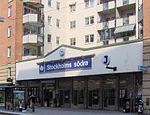2010 IFAF Women's World Championship
2010 in American football2010 in Swedish women's sport2010s in StockholmIFAF Women's World ChampionshipInternational sports competitions hosted by Sweden ... and 3 more
International sports competitions in StockholmJuly 2010 sports events in EuropeJune 2010 sports events in Europe
The 2010 IFAF Women's World Championship was the first world championship of American football for women. It was held in Stockholm, Sweden, from 26 June to 3 July 2010.
Excerpt from the Wikipedia article 2010 IFAF Women's World Championship (License: CC BY-SA 3.0, Authors).2010 IFAF Women's World Championship
Ottsjövägen, Stockholm Årsta (Enskede-Årsta-Vantörs stadsdelsområde)
Geographical coordinates (GPS) Address Nearby Places Show on map
Geographical coordinates (GPS)
| Latitude | Longitude |
|---|---|
| N 59.304444444444 ° | E 18.05 ° |
Address
Årstadals Båtklubb
Ottsjövägen
120 54 Stockholm, Årsta (Enskede-Årsta-Vantörs stadsdelsområde)
Sweden
Open on Google Maps










